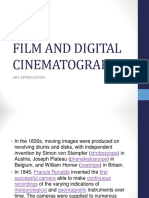0 ratings0% found this document useful (0 votes)
8 viewsCinema Technique
Cinema Technique
Uploaded by
hosein mohamadiThe document discusses the history and techniques of cinema and cinematography. It describes how early film cameras were mounted on tripods or vehicles, allowing for some of the first camera movements. It then discusses the development of camera heads that allowed for panning shots. The document also provides details on film studio designs and lighting techniques used in early studios. Additionally, it examines the history and artistic uses of black and white cinematography, and how it allows filmmakers to emphasize visual elements like contrast, texture, and lighting. Finally, it briefly outlines some common styles of cinematography like realism, classic Hollywood, and film noir.
Copyright:
© All Rights Reserved
Available Formats
Download as PDF, TXT or read online from Scribd
Cinema Technique
Cinema Technique
Uploaded by
hosein mohamadi0 ratings0% found this document useful (0 votes)
8 views2 pagesThe document discusses the history and techniques of cinema and cinematography. It describes how early film cameras were mounted on tripods or vehicles, allowing for some of the first camera movements. It then discusses the development of camera heads that allowed for panning shots. The document also provides details on film studio designs and lighting techniques used in early studios. Additionally, it examines the history and artistic uses of black and white cinematography, and how it allows filmmakers to emphasize visual elements like contrast, texture, and lighting. Finally, it briefly outlines some common styles of cinematography like realism, classic Hollywood, and film noir.
Original Description:
Cinema technique
Original Title
Cinema technique
Copyright
© © All Rights Reserved
Available Formats
PDF, TXT or read online from Scribd
Share this document
Did you find this document useful?
Is this content inappropriate?
The document discusses the history and techniques of cinema and cinematography. It describes how early film cameras were mounted on tripods or vehicles, allowing for some of the first camera movements. It then discusses the development of camera heads that allowed for panning shots. The document also provides details on film studio designs and lighting techniques used in early studios. Additionally, it examines the history and artistic uses of black and white cinematography, and how it allows filmmakers to emphasize visual elements like contrast, texture, and lighting. Finally, it briefly outlines some common styles of cinematography like realism, classic Hollywood, and film noir.
Copyright:
© All Rights Reserved
Available Formats
Download as PDF, TXT or read online from Scribd
Download as pdf or txt
0 ratings0% found this document useful (0 votes)
8 views2 pagesCinema Technique
Cinema Technique
Uploaded by
hosein mohamadiThe document discusses the history and techniques of cinema and cinematography. It describes how early film cameras were mounted on tripods or vehicles, allowing for some of the first camera movements. It then discusses the development of camera heads that allowed for panning shots. The document also provides details on film studio designs and lighting techniques used in early studios. Additionally, it examines the history and artistic uses of black and white cinematography, and how it allows filmmakers to emphasize visual elements like contrast, texture, and lighting. Finally, it briefly outlines some common styles of cinematography like realism, classic Hollywood, and film noir.
Copyright:
© All Rights Reserved
Available Formats
Download as PDF, TXT or read online from Scribd
Download as pdf or txt
You are on page 1of 2
Cinema technique
Georges Méliès (left) painting a backdrop in his studio
The first film cameras were fastened directly to the head of a tripod or other support, with only the
crudest kind of leveling devices provided, in the manner of the still-camera tripod heads of the
period. The earliest film cameras were thus effectively fixed during the shot, and hence the first
camera movements were the result of mounting a camera on a moving vehicle. The first known of
these was a film shot by a Lumière cameraman from the back platform of a train leaving
Jerusalem in 1896, and by 1898, there were a number of films shot from moving trains. Although
listed under the general heading of "panoramas" in the sales catalogues of the time, those films
shot straight forward from in front of a railway engine were usually specifically referred to as
"phantom rides."
In 1897, Robert W. Paul had the first real rotating camera head made to put on a tripod, so that
he could follow the passing processions of Queen Victoria's Diamond Jubilee in one
uninterrupted shot. This device had the camera mounted on a vertical axis that could be rotated
by a worm gear driven by turning a crank handle, and Paul put it on general sale the next year.
Shots taken using such a "panning" head were also referred to as "panoramas" in the film
catalogues of the first decade of the cinema. This eventually led to the creation of a panoramic
photo as well.
The standard pattern for early film studios was provided by the studio which Georges Méliès had
built in 1897. This had a glass roof and three glass walls constructed after the model of large
studios for still photography, and it was fitted with thin cotton cloths that could be stretched below
the roof to diffuse the direct ray of the sun on sunny days. The soft overall light without real
shadows that this arrangement produced, which also exists naturally on lightly overcast days,
was to become the basis for film lighting in film studios for the next decade.
Black and white cinematography is a technique used in filmmaking where the images are
captured and presented in shades of gray, without color. This artistic approach has a rich history
and has been employed in various films throughout cinema's evolution. It is a powerful tool that
allows filmmakers to emphasize contrast, texture, and lighting, enhancing the visual storytelling
experience. The use of black and white cinematography dates back to the early days of cinema
when color film was not yet available. Filmmakers relied on this technique to create visually
striking and atmospheric films. Even with the advent of color film technology, black and white
cinematography continued to be utilized for artistic and thematic purposes. Ken Dancyger's book,
"The Technique of Film and Video Editing: History, Theory, and Practice," provides valuable
insights into the historical and theoretical aspects of black and white cinematography. Dancyger
explores how this technique has been employed throughout film history, examining its impact on
storytelling, mood, and visual aesthetics. The book delves into the artistic choices and technical
considerations involved in creating compelling black and white imagery, offering a comprehensive
understanding of the technique.
Black and white cinematography allows filmmakers to focus on the interplay of light and shadow,
emphasizing the contrast between different elements within a scene. This technique can evoke a
sense of nostalgia, evoke a specific time period, or create a timeless and classic feel. By stripping
away color, filmmakers can emphasize the composition, shapes, and textures within the frame,
enhancing the visual impact. Notable films that have employed black and white cinematography
include classics such as "Casablanca" (1942), "Raging Bull' (1980), and "Schindler's List" (1993).
These films showcase the power and versatility of black and white cinematography in creating
emotionally resonant visuals. Black and white cinematography remains a relevant and widely
used technique in modern filmmaking. It continues to be employed by filmmakers to evoke
specific moods, convey a sense of timelessness, and enhance the artistic expression of their
stories.
There are many types of Cinematography that each differ based on production purpose and
process. These different types of Cinematography are similar in the sense that they all have the
goal of conveying a specific emotion, mood or feeling. For each different style however they can
often convey different emotions and purposes. Some examples of different types of
Cinematography can be known as Realism. This style of cinematography aims to create a
realistic portrayal of the world, often using natural lighting, handheld cameras, and a
documentary-like approach to filming. Classic Hollywood is a style of cinematography
characterized by its use of highly polished, studio-produced films with glamorous sets, bright
lighting, and romanticized narratives. Film Noir is a style of cinematography that is characterized
by its use of stark contrast and chiaroscuro lighting, low-key lighting, and a dark, brooding
atmosphere. It often features crime, mystery, and morally ambiguous characters.
You might also like
- History of Film PDFDocument25 pagesHistory of Film PDFJaime Quintero75% (4)
- Trial Assignment - Business Analyst (Time Series Modeling)Document2 pagesTrial Assignment - Business Analyst (Time Series Modeling)Rathor SushantNo ratings yet
- History of Film PDFDocument25 pagesHistory of Film PDFSadaf Zohra100% (1)
- PRC Good Standing Authorization Sample From AbroadDocument2 pagesPRC Good Standing Authorization Sample From AbroadMayvoren Gaona Visaya90% (10)
- What Is Ballasting and deDocument5 pagesWhat Is Ballasting and dezalzizaNo ratings yet
- Cinematography (FromDocument12 pagesCinematography (FromMouaci Nwl0% (1)
- CinemafilmsDocument18 pagesCinemafilmsAlyssa ValladolidNo ratings yet
- CinematographyDocument12 pagesCinematographyElaisa Mae Delos SantosNo ratings yet
- Research On CinematographyDocument6 pagesResearch On Cinematographyapi-477577268No ratings yet
- IntroductionDocument39 pagesIntroductionsravan kumarNo ratings yet
- Cinematography ScriptDocument5 pagesCinematography Scriptapi-481638701No ratings yet
- History of FilmDocument6 pagesHistory of Filmapi-436004944No ratings yet
- script (5)Document19 pagesscript (5)David BrainardNo ratings yet
- Proiect PDFDocument2 pagesProiect PDFAnghel AlinNo ratings yet
- A Very Brief History of CinematographyDocument2 pagesA Very Brief History of CinematographyMaría Florencia BorrelloNo ratings yet
- Cinematography 2Document34 pagesCinematography 2Sreekant NairNo ratings yet
- Movies - CommunicationDocument32 pagesMovies - Communicationpicorioscarolina7No ratings yet
- 428939the Ultimate Cheat Sheet On MoviesDocument5 pages428939the Ultimate Cheat Sheet On Moviesp4korgz503No ratings yet
- Arts 10 (Film) - q3Document44 pagesArts 10 (Film) - q3Abegail ComiaNo ratings yet
- Introduction To Filmmaking: Production DesignDocument21 pagesIntroduction To Filmmaking: Production DesignMirko von BernerNo ratings yet
- Cinematography ScriptDocument7 pagesCinematography Scriptapi-477398143No ratings yet
- Animation Techniques ScriptDocument7 pagesAnimation Techniques Scriptapi-307173204No ratings yet
- Document 19Document6 pagesDocument 19joe joeNo ratings yet
- Docs 8Document7 pagesDocs 8Jobelle RafaelNo ratings yet
- Cinema Technique: Adding Citations To Reliable Sources RemovedDocument2 pagesCinema Technique: Adding Citations To Reliable Sources RemovedKishor RaiNo ratings yet
- Film, Also Called Movie, Motion Picture or Moving Picture, Is ADocument3 pagesFilm, Also Called Movie, Motion Picture or Moving Picture, Is APutri UfairahNo ratings yet
- Document 1Document2 pagesDocument 1api-264856663No ratings yet
- Filming NotesDocument9 pagesFilming NotesantoniokisemboNo ratings yet
- Week 8 - Avant GardeDocument21 pagesWeek 8 - Avant Garde이현규No ratings yet
- Alana Irvine EssayDocument4 pagesAlana Irvine Essayapi-692250032No ratings yet
- Film and Digital CinematographyDocument14 pagesFilm and Digital CinematographyRyan Martinez100% (1)
- Arts 3RDDocument6 pagesArts 3RDGeorge Blaire RasNo ratings yet
- History of The Cinema - CópiaDocument10 pagesHistory of The Cinema - CópiaNatalia NobreNo ratings yet
- Silent FilmDocument5 pagesSilent FilmVanellope VonschweettzNo ratings yet
- Topic InvestigationDocument6 pagesTopic Investigationapi-634297693No ratings yet
- Orson Welles's The Trial Film Noir and The Kafkaesque - J. AdamsDocument19 pagesOrson Welles's The Trial Film Noir and The Kafkaesque - J. AdamsTheaethetus0% (1)
- Anamorphic De-Squeeze White PaperDocument10 pagesAnamorphic De-Squeeze White PaperluisregNo ratings yet
- Cinematography ProposalDocument5 pagesCinematography Proposalgoldeneye7623No ratings yet
- 2017 Reframing Cinematography - ACS Article - Daniel Maddock - SVDocument6 pages2017 Reframing Cinematography - ACS Article - Daniel Maddock - SVmartin perezNo ratings yet
- Cinema VeriteDocument20 pagesCinema VeriteFarid AhmadNo ratings yet
- Recording and Transmission of Film: PrecursorsDocument5 pagesRecording and Transmission of Film: PrecursorsKate Minović100% (1)
- Film HistoryDocument33 pagesFilm Historyrosa rashidNo ratings yet
- Group10 ReportDocument85 pagesGroup10 ReportKristine CaagbayNo ratings yet
- Forsensic Photography 1 1Document56 pagesForsensic Photography 1 1bunniecaronan113003No ratings yet
- Special Effects WikiDocument8 pagesSpecial Effects WikimagusradislavNo ratings yet
- Animated Documentary - Technological Change and Experimentation - India Mara MartinsDocument3 pagesAnimated Documentary - Technological Change and Experimentation - India Mara MartinsMatt GouldNo ratings yet
- Film History: A Brief Encounter: Key Moments From The History of Film and Film TechnologyDocument15 pagesFilm History: A Brief Encounter: Key Moments From The History of Film and Film TechnologyNiguss GirmaNo ratings yet
- Photography AssignmentDocument10 pagesPhotography AssignmentjoeNo ratings yet
- Flim StudiesDocument14 pagesFlim StudiesPavithNo ratings yet
- History of Media Notes - Unit 4Document20 pagesHistory of Media Notes - Unit 4ShubhangiNo ratings yet
- History of CinemaDocument39 pagesHistory of CinemaPrachi PhartiyalNo ratings yet
- Film Studies NotesDocument13 pagesFilm Studies NotesAysha Rosna AlungalNo ratings yet
- Notes Jai HindDocument14 pagesNotes Jai HindAnadyaNo ratings yet
- Art - The History of CinemaDocument29 pagesArt - The History of CinemaAlloySebastinNo ratings yet
- Cinematography Video Essay ScriptDocument3 pagesCinematography Video Essay Scriptapi-477397447No ratings yet
- Q3 G10 MUSIC ARTS-pages-DeletedDocument4 pagesQ3 G10 MUSIC ARTS-pages-DeletedKermit GooeyNo ratings yet
- Cine y TelevicionDocument5 pagesCine y TelevicionDalia Rodríguez QuirósNo ratings yet
- RC2 Lesson1 History of Film Philippines and AbroadDocument40 pagesRC2 Lesson1 History of Film Philippines and Abroad1EMonica Mae LorescaNo ratings yet
- History of FilmDocument7 pagesHistory of Filmapi-433604806No ratings yet
- The World of CinemaDocument53 pagesThe World of CinemaDaniela RotaruNo ratings yet
- Birth of Cinema-1699250329-1061916472Birth of Cinema & Optical IllusionsDocument18 pagesBirth of Cinema-1699250329-1061916472Birth of Cinema & Optical IllusionsBenNo ratings yet
- Mo Vies HDDocument2 pagesMo Vies HDmen83desireNo ratings yet
- Cases On Nominal Damages - TranspoLawDocument3 pagesCases On Nominal Damages - TranspoLawMichael SollerNo ratings yet
- Coca-Cola Enterprises CRS Report 2011Document23 pagesCoca-Cola Enterprises CRS Report 2011Alexandra DumitrescuNo ratings yet
- Birth Injuries: By: Murad Sawalha RN, MSNDocument18 pagesBirth Injuries: By: Murad Sawalha RN, MSNPriyanka JainNo ratings yet
- BARTIKO Et Al. 2019. Spatial and Seasonal Patterns of Flood Change Across BrazilDocument10 pagesBARTIKO Et Al. 2019. Spatial and Seasonal Patterns of Flood Change Across BrazilGraziellaLaricaNo ratings yet
- Cad Cheat SheetDocument1 pageCad Cheat Sheetjpdbautista2921No ratings yet
- AiDocument28 pagesAiGobiNo ratings yet
- Umami Main MenuDocument1 pageUmami Main MenuGerardo Kepint SantosoNo ratings yet
- Strategy and Operating Model - RFP v.04Document13 pagesStrategy and Operating Model - RFP v.04Onice BallelosNo ratings yet
- Road Maintenance SpecificationsDocument88 pagesRoad Maintenance Specificationspeter093100% (2)
- Application For Provisional License (For One Year House Job Only) NewDocument2 pagesApplication For Provisional License (For One Year House Job Only) NewmaahNo ratings yet
- Stars 100 LYDocument120 pagesStars 100 LYGary MorrisNo ratings yet
- First PartyDocument12 pagesFirst PartyparenzofevyjeanNo ratings yet
- Ship ClippingsDocument24 pagesShip ClippingsIke MastahNo ratings yet
- Economic Offences Wing, Delhi Police Mission Statement: PurposeDocument2 pagesEconomic Offences Wing, Delhi Police Mission Statement: PurposeHemant JainNo ratings yet
- Vendor Registeration Form: Bangalore International Airport LTD.Document2 pagesVendor Registeration Form: Bangalore International Airport LTD.aman3327100% (2)
- Accounts Revision QuestionsDocument293 pagesAccounts Revision QuestionsRishab Gupta100% (1)
- Quality Assurance in IV TherapyDocument37 pagesQuality Assurance in IV TherapyMalena Joy Ferraz VillanuevaNo ratings yet
- Catalog: Full Range of Products For Veterinary MedicineDocument23 pagesCatalog: Full Range of Products For Veterinary MedicinedmantsioNo ratings yet
- Respiratory System ReviewerDocument7 pagesRespiratory System ReviewerDaniel DanielNo ratings yet
- Hs Football Signals 1Document4 pagesHs Football Signals 1Terrance BrownNo ratings yet
- SCCO LKT Per 31 Des 2022Document87 pagesSCCO LKT Per 31 Des 2022Jefri Formen PangaribuanNo ratings yet
- Markets&MarketLogic SteidlmayerP&KoyK 1986.R-optsDocument177 pagesMarkets&MarketLogic SteidlmayerP&KoyK 1986.R-optsERNEST CHIBUZO OGUNo ratings yet
- 5G Ready 0.04-12.4 GHZ RF & Microwave Antenna Lab MAT12Document8 pages5G Ready 0.04-12.4 GHZ RF & Microwave Antenna Lab MAT12Amit SharmaNo ratings yet
- Base SystemDocument13 pagesBase Systemprotocolz0% (1)
- GATE-2011 Physics Question PaperDocument16 pagesGATE-2011 Physics Question PaperDavid HudsonNo ratings yet
- Admit Card Babita 2023 ReDocument1 pageAdmit Card Babita 2023 Reash kathumNo ratings yet
- HCL - Test 1Document12 pagesHCL - Test 1DHANASEENUVASAN DNo ratings yet

























































































